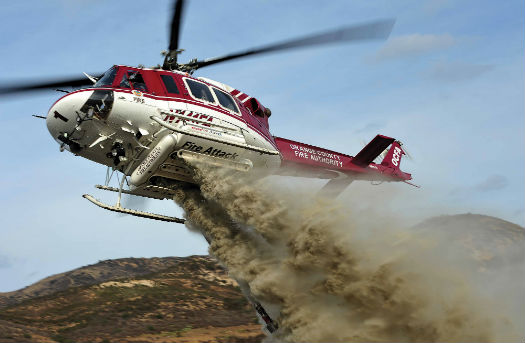
With two Bell 412EPs equipped with hoists and belly tanks, the Orange County Fire Authority (OCFA) is both a firefighting and rescue organization.
In 1993, California’s Orange County endured a devastating fire season. All told, fires burned across 36,000 acres, severely damaging or destroying 469 homes. The experience reinvigorated the Orange County Fire Department’s (OCFD’s) desire to get hold of its own firefighting helicopter. It had looked at the possibility of doing so throughout the previous decade, but the costs were prohibitive. However, a new federal program provided the perfect opportunity for the OCFD to get not just one, but a small fleet of helicopters with which it could begin an aerial firefighting section. Retired U.S. Army Bell UH-1H Hueys were being released by the Department of Defense to the U.S. Forest Service for distribution to states as Federal Excess Personal Property (FEPP) for wildland firefighting — and the OCFD was able to procure three of them.
However, the next fire season arrived before the department was able to start converting the airframes, so it contracted a firefighting Bell 205A++ from Evergreen Helicopters for the year. And, when the helicopter responded to its first incident on June 22, 1994, the department was officially in the aerial firefighting business.
Meanwhile, San Joaquin Helicopters, based in Delano, Calif., began a conversion process to turn two of the Hueys into UH-1H Super Hueys. This involved replacing the 1,400 shaft-horsepower Lycoming T53-L-13 engine with the considerably more powerful 1,800 shaft-horsepower T53-L-703, and adding Bell 212 tail boom, tail rotor, and main rotor blades. The aircraft also received a new communications package and a 360-gallon (1,360-liter) Isolair belly-mounted water tank with foam and hover snorkel capability.

OCFA paramedics and flight crew unload equipment during a mountain rescue.
The Super Hueys weren’t completed in time for the 1995 fire season, so the OCFD decided to paint and slightly modify its third UH-1H and fly it with a Bambi bucket for the summer. This helicopter — “Copter 341” — performed well, and gave the pilots and crews of OCFD’s air operations section the experience of operating their own helicopter. The section was based in a small hangar at John Wayne Airport, which was designated as Station No. 33.
As the operation was set to expand, the department began the search for a larger hangar that would be able to fit multiple helicopters. The air operations section also needed more space to allow its various personnel — the battalion chief, pilots, crew chiefs and maintenance personnel — the room to complete their daily tasks. It eventually found space at Fullerton Municipal Airport, located in the center of the county, and moved into a new hangar there — and was re-designated as Station No. 41.
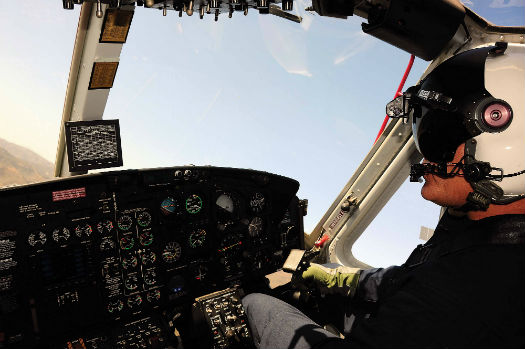
Lead pilot Jeff Carlson sets up a left turn during an offsite landing.
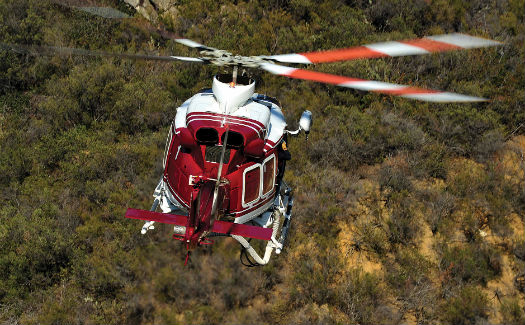
The Bell 412EP is considered an excellent firefighting and hoisting platform by OCFA pilots.
The Orange County Fire Authority (as it was then known) finally took delivery of the first Super Huey, designated “Copter 41,” in 1996, and it was joined by the second Super Huey (“Copter 241”) the following year. The section also received two helicopter tender trucks through the FEPP program to support the aircraft during outlying field operations. The original unmodified Huey — Copter 341 — continued to operate for a couple more years until it was retired and returned to the FEPP program.
Fire & Rescue
The idea of providing an air rescue capability was considered early during the development of the program. “With the amount of recreational activity in our local mountains, a hoist capable helicopter and crew made sense for us,” Fire Captain David Lopez told Vertical. (Lopez, who has been with air operations section for its entire 20 years, is considered its unofficial historian). In 1999, the section bought a Goodrich external rescue hoist, and made provisions to enable it to be mounted on either aircraft. Today, day and night hoist operations are performed on a routine basis.
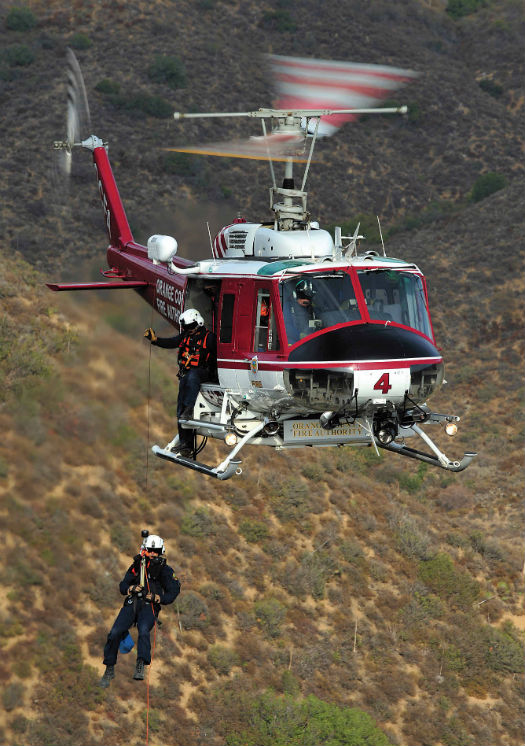
Copter 4 — a Bell UH-1H Super Huey — performs a hoisting operation in the local mountains.
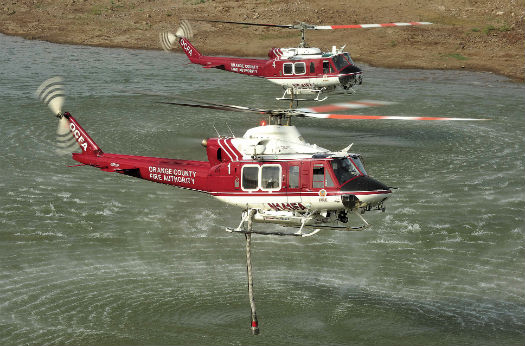
During a fire, the OCFA can use Lake Irvine as a close water source for water drop operations. Here “Copter 1” and “Copter 4” get ready to hover fill.
The next evolutionary step for the section was to begin using night vision goggles (NVGs) in its operations.
“We knew night firefighting was critical — it’s the time of day where a fire is at its low point of intensity, [so] is the time we can really get a hold of a moving fire,” said chief pilot Jeff Carlson.
In 2005, the section was approved to buy the latest generation ANVIS-9 goggles and implement them in its operations.
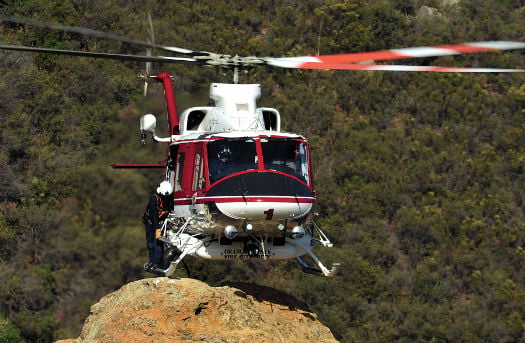
Tight fits are routine for OCFA air ops. Here, Copter 1 drops off a paramedic.
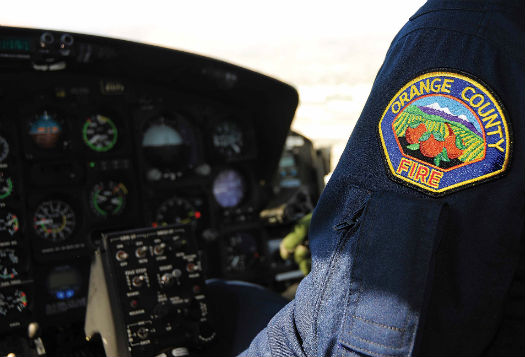
The OCFA’s air operations department celebrated its 20th anniversary in 2014.
“We have been trained to use the NVGs during both fire operations and night search-and-rescue or hoist missions,” said Carlson. “To say they are a game changer is an understatement — the level of safety and situational awareness is immeasurable compared to not having them. Over the last five years we have brought together multiple local and federal airborne firefighting agencies for joint night firefighting training .We have done this every year at different locations and it only helps when different agencies need to work together at night during water dropping operations.”
The Orange County Fire Authority (OCFA) decided to expand its helicopter fleet in 2008, ordering two brand new Bell 412EPs. These were delivered with the latest communication and moving map systems, as well as Simplex belly tanks with hover-fill snorkel capability. The section took the opportunity to create a colorful new rich red and white paint scheme for its fleet, and all four helicopters were designated with a new 1 to 4 numbering system.
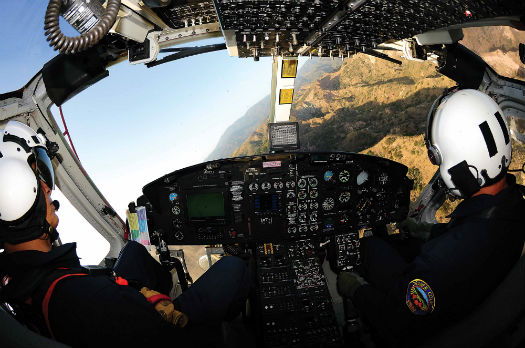
Although densely populated, Orange County also has plenty of mountainous terrain in which people can get in trouble.
The air operations section moved to the other side of Fullerton Municipal Airport in 2012, to what is expected to be its home for the foreseeable future. The newly-built 22,000-square-foot hangar includes three well-lit large hangar bays, with a built in overhead crane, providing for a substantial and roomy maintenance area. There’s a separate office area and a second-story crew quarters with showers and a training room. The facility also includes a kitchen area and day room with a view over the entire flight line.
In January, the section plans to go to a 24/7 schedule to provide round-the-clock availability to the county’s residents, and hopes to also have a paramedic stationed with it at all times by next summer. “Right now, we rendezvous with paramedics at different county locations,” said Lopez. “To save critical time we want to eliminate that step.”

With the recent acquisition of two new 412EPs, the OCFA is well set for the future.
And, with the possible elimination of Coast Guard Air Station Los Angeles, the section is moving forward with offshore rescue training. “With the amount of boating off Orange County’s coast, and because we operate twin-engine aircraft, we feel it’s prudent to have the ability to perform offshore rescues,” Lopez added.
Now 20 years into its history, OCFA’s air operations section is a well-embedded element of Orange County’s emergency response capability. And with new competencies being added all the time, it seems well set to continue offering an ever-greater level of service to the county’s citizens in the future.
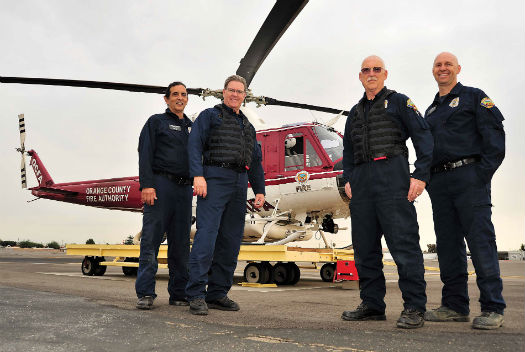
From left to right: Air operations captain and lead crew chief David Lopez; lead pilot Jeff Carlson; pilot Jim Davidson; crew chief Kenny Dossey.






I loved your article on the fire and rescue helicopter. I am a 29 yr old man with Autism and spend my time looking at the computer for heavy equipment and emergency articles. I’m turning 30 on my next birthday and would like you to come to my birthday party. Thank you, Erik Longtin